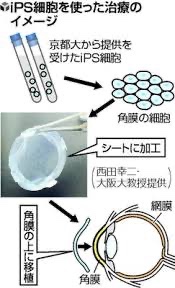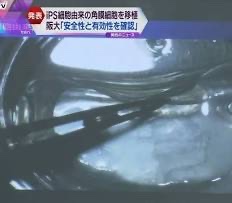

大阪大学:iPS细胞角膜移植成功4例:
– 视力从 0.04 提高到 0.3-
-以3年内实用化为目标-
角膜移植的实际应用:
我们离iPS细胞角膜移植的实际应用又近了一步。它是
大阪大学
西田浩司教授
研究团队:
献给四位因眼角膜疾病几乎失明的三七十岁男女
移植了 iPS 细胞片状角膜。
调查一年的进度:
结果,矫正视力为0.04的患者人数提高到了0.3。
前三个:
我的视力恢复到不影响日常生活的程度。
剩下的一个:
这意味着角膜不再混浊。
常规角膜移植壁:
排斥一直是传统角膜移植中的一个问题。
这四个人都没有排斥或感染传染病。
3年内实际使用:
研究团队明年也将与公司进行临床试验。
我想最快在三年内实现实用化。
https://www.asahi.co.jp/webnews/pages/abc_14589.html
Universität Osaka: 4 erfolgreiche Fälle von iPS-Zell-Hornhauttransplantation:
-Verbesserte Sehkraft von 0,04 auf 0,3-
-Anstrebungen für den praktischen Einsatz in 3 Jahren-
Praktische Anwendung der Hornhauttransplantation:
Wir sind der praktischen Anwendung der Hornhauttransplantation mit iPS-Zellen einen Schritt näher gekommen.
Osaka-Universität
Professor Koji Nishida
Forschungsgruppe:
Für vier Männer und Frauen in den Dreißigern und Siebzigern, die aufgrund einer Erkrankung der Hornhaut des Auges fast ihr Augenlicht verloren haben
Eine iPS-Zellblatt-ähnliche Hornhaut wurde transplantiert.
Untersuchen Sie den Fortschritt eines Jahres:
Dadurch verbesserte sich die Zahl der Patienten mit einer korrigierten Sehschärfe von 0,04 auf 0,3.
Die ersten drei:
Mein Sehvermögen erholte sich soweit, dass es mein tägliches Leben nicht mehr beeinträchtigte.
Der Rest:
Das bedeutet, dass die Hornhaut nicht mehr getrübt ist. Es war
Die Wand der konventionellen Hornhauttransplantation:
Abstoßung war ein Problem bei herkömmlichen Hornhauttransplantationen.
Alle vier hatten keine Abstoßung oder Infektion mit Infektionskrankheiten. Es war
Praxiseinsatz in 3 Jahren:
Das Forschungsteam wird auch im nächsten Jahr klinische Studien mit Unternehmen durchführen.
Den Praxiseinsatz möchte ich frühestens in drei Jahren anstreben.
Team: iPS-derived cornea transplant proved safe, effective
NHK WORLD-JAPAN
News Monday, April 4,A team of researchers in Japan says
it has confirmed thattransplants of corneal tissue derived from induced pluripotent stem cells, or iPS cells, are safe and effective.
The team led by Osaka University Professor Nishida Koji announced its findings on Monday.
iPS cells
are created by reprogramming ordinary human cells and have the ability to develop into any type of cell.Researchers transplanted
iPS-deriv sheet-like corneal tissues into four patients who were between the age of 30 years and up to 79 years old.Their eyesight had significantly deteriorated due to a disease of the cornea.
The team says
none of the recipients had rejection or developed severe side effects one year after their transplants.Three of them
recovered eyesight to levels good enough to lead their daily lives without difficulties.The fourth recipient’s cornea
became transparent, but the results of vision tests varied.Researchers say
this method carries a lower risk of rejection than cornea from donors,and they are more transparent than cornea cell sheets made from mucus membrane from the mouth.
Professor Nishida hailed the findings as significant, and said
the team wants to put its method into practical use soon so patients around the world can benefit.
The team aims to start a clinical trial next year at the earliest as a step toward obtaining government approval as a treatment.